
The Surya Namaskar is a complete body-mind workout. Shameem Akhtar takes you through the 12-pose sun salutation flow.
The Surya Namaskar works out the whole body and is a mind-stimulating practice. It is the perfect aerobic exercise. It can be used as a warm-up: not just for yogic asana practice, but also for any other form of exercise. It is also an ideal way to stretch after any hectic workout.
It boosts energy by tweaking major endocrine glands. It boosts immunity. Since it also works the lymphatic drainage system, it is also a detox method. In yoga, the Surya Namaskar is believed to clear the energy pathways in the body. It is also used to treat depression and is the best retort to obesity. Even in chronic cases of the circulatory system, though it is not initially taught, it may be used in later stages when taught in a phased manner to boost health and stamina.
Its cosmetic value is equally impeccable. It is said to promote hair growth and give a super glow to the skin. It keeps the limbs toned. Some of its postures, like the standing crescent, and the downward-facing dog pose tone the hands and legs superbly.
In the young, it is said to harmonise the growth of the mind and body. In fact, when it is taught from eight years on and practiced regularly, it can delay puberty to the child's advantage, so that the brain-body growth is matched. The entire digestive tract is thoroughly toned, so that the gut becomes healthy.
It is so compact that even if you do not have time, you can still commit a few minutes to practice, with just a few rounds, to be assured of perfect health.
In the following pages, we take you through the 12-pose sun salutation flow.
Note:
Also note, there are several other Sanskrit names for the poses. We have kept to the most common names for the sake of convenience.
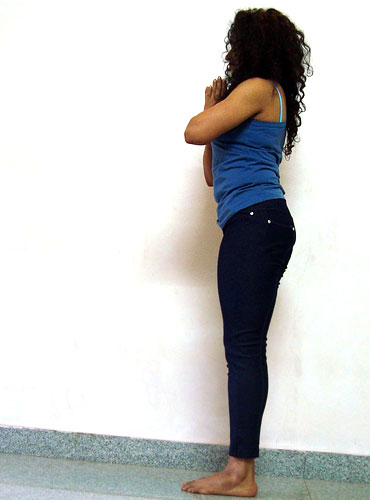
Stand up straight. Keep hands folded at the chest, in the gesture of prayer. Inhale and exhale.
Benefits: This grounds you and prepares you for the flow. Ensure the feet are touching lightly inward. This will challenge your balance and work the subtle muscle mass, called fascia.
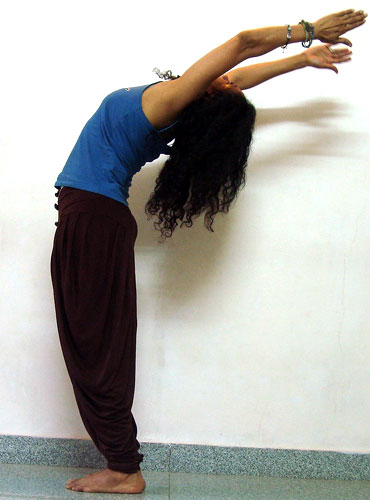
Inhale, raise hands overhead, looking up. Drop the hands as far back as possible by arching the spine. Focus on the feet to ensure you do not lose your balance. Ensure you are not bending at the knees. Keeping the feet together, unless you are obese, is a good way of maximising the tone-up benefits of the pose.
Benefits: It is therapeutic for lower back ache. Used as therapy in diabetes, heart problems and other circulatory problems. Tones hands, legs, especially back of thighs.

From the crescent pose, exhaling, reach both hands to the mat/ground. Bend legs at the knees, if required. It is important to drop your head to look at the thighs. Both hands have to be on the mat, since the next pose flows from that.
Benefits: It tones the entire digestive tract. Gives a glow to the face. Soothes the brain. Tones hands and legs. Improves sense of balance.
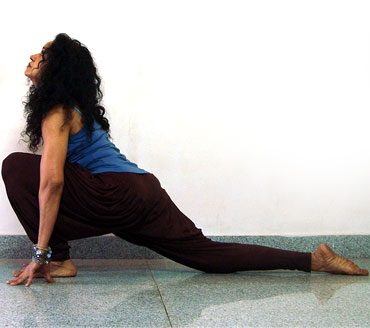
Also called the crescent, you move to this pose from the horse pose to move the right leg back as you inhale. When placing the foot behind, the toes may be curled in (easier to do that) or you may place the back of the right foot on the mat (this involves extension at the ankle joint and is a slightly more advanced variation). The right knee is on the mat, as shown. The left knee remains bent as the foot continues to remain between the hands.
Benefits: Makes the body flexible. Works the entire spine. Works on most major endocrine glands. The pressure at the thyroid helps promote weightloss and metabolic efficiency.
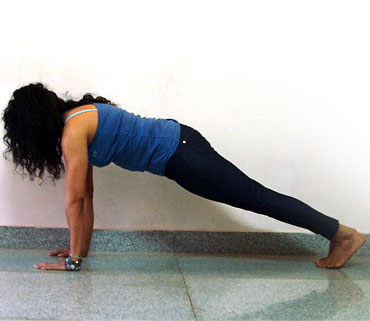
Hold the breath, to move the left leg back as shown. The weight should shift to the hands and feet. Body should be straight. Look ahead.
Benefits: Builds stamina and focus. Corrects spinal misalignments.
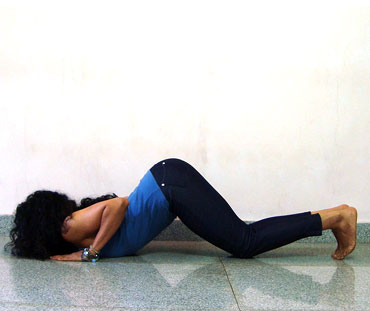
Exhaling, drop first to the knees. Then bend the chest and the chin or forehead to the ground. This is the actual sun salute prayer pose, where eight parts of the body are touching the ground. The body creates a wave-like flow.
Benefits: It prevents abdominal sagging, tones the stomach, healing stomach ailments. Flexes the spine, making you more flexible. Tones legs. Is a de-stressing pose, wringing tension lodged in the body.
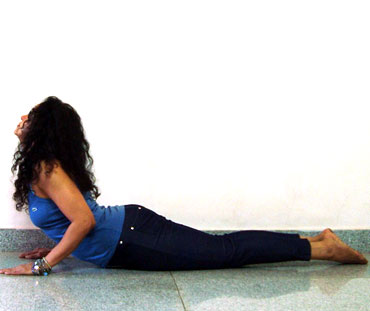
Inhale. From the eight-limbed prayer pose slide into the cobra pose by lifting chin and chest off the ground. Ensure elbows remain close to the body, the shoulders are not tensed or drawn up. The face should be tilted up and back, and the stomach should not be too much off the ground; this will reduce the benefits of the pose and also not create the desired strength in your wrists. Unless overweight, ensure the legs remain together.
Benefits: It is used to treat lower back problems. Resolves digestive disorders. Is therapeutic in diabetes, heart problems and circulatory disorders. Relieves stress. Tones hands and legs powerfully.
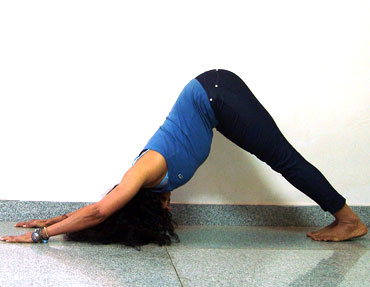
Also called the parvatasana or the mountain pose. To do this, curl your toes in, lifting hips off the ground. Exhale. Press down heels, push from the shoulders. Look at the stomach or between big toes.
Benefits: This pose is a cure-all pose, used to treat all spinal problems. Builds mental and physical stamina, by toning and working out the entire body. The face gets a glow due to the downward resistance it gives to the entire head. The blood rush to the brain is relaxing and de-stressing. Used to treat heart problems also.

Dropping the left knee you must draw the right foot ahead, between the hands. Head should be thrown back. Pushing from the hips will deepen the pose which, if held, should create a curve (replicating the crescent) from head to toe.
Benefits: As previously mentioned.

Exhale. Draw the left leg ahead to complete the pose, so the head hangs loose and your hands are on either side of the legs. Bend the knees if you must.
Benefits: As previously mentioned.
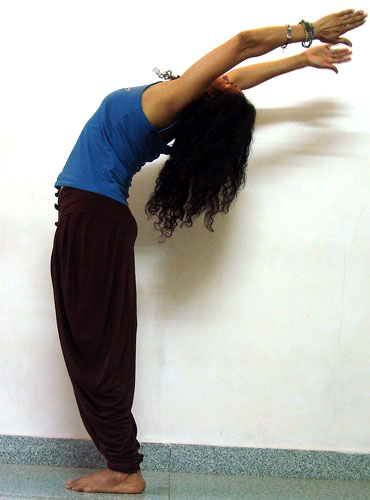
Inhale, drawing the hands overhead, focusing on the feet, arms raised straight above.
Benefits: As previously mentioned.

Exhale to drop hands at the sides or hold them in a prayer pose at the chest.
Benefits: As previously mentioned.